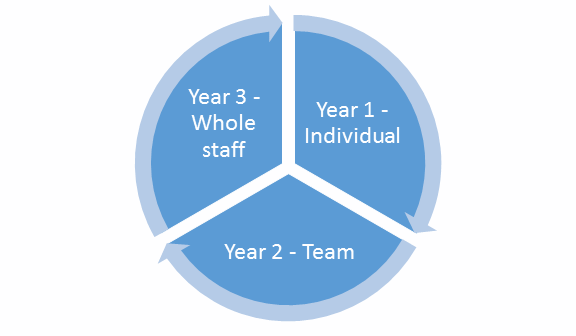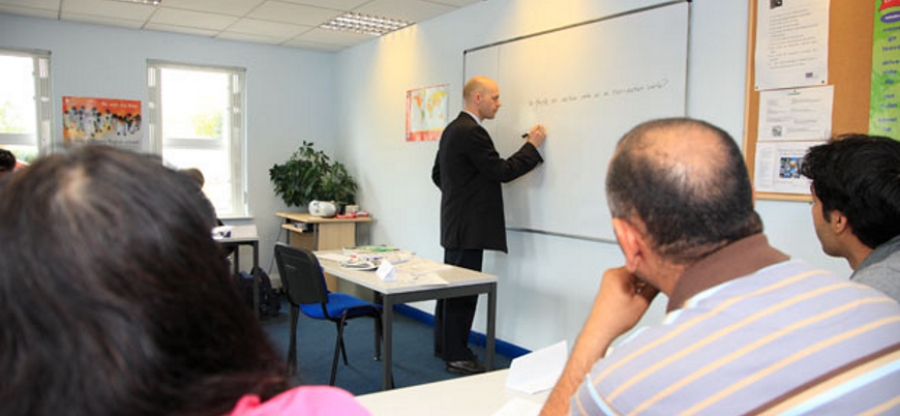"Learning is messy and does not always follow the school year calendar."
Now, as we finish up another school year and begin to analyze how far we have come and what we want to develop for next year, I am left thinking about – what really works? How can we best organize professional development for our teachers so that they find it meaningful, and are motivated to continue to engage to find the best possible solutions for our students?
One thing I know for sure is what not to do... no more ‘one-size-fits-all’ programmes. All of our staff members are at different places in their personal and professional development. They all learn differently, are interested in different aspects of student learning and work with different student groups. So, how could we have ever assumed that we could find one program or topic that would interest and engage them all equally?
Another thing I had to let go of was that all professional development should run the length of a school year and be completely done, reported and analysed by summer vacation. Learning is messy and does not always follow the school year calendar. It’s okay if this year’s students didn’t necessarily benefit from a teacher’s new learning, next year’s group will!
Maybe the most important thing I had to let go of... control. I can no longer plan a professional development programme for my teachers based on what I think their needs are. Time and time again when I meticulously planned our staff development in June for the coming year, I missed the mark. At best, I was reaching 60-75% of teachers and I often missed authentic learning opportunities for our staff, because I was too locked into our planned schedule of further education to engage in and address real learning opportunities for staff then and there.
Sound familiar? Enough about what not to do, here is what I have found to be true.
Teachers, like students, want choice of path and pace. They learn differently and at different tempos, and we have to allow this flexibility so that everyone feels included. Teachers like students want to have influence (real influence) over activities and methods used. Teachers, like students, want real and relevant topics that engage them where they can see connections between what they are learning and the whole “world” around them. Teachers, like students, have different workloads during the course of a school year, and want to be challenged, but not overloaded. Teachers, like students, want their learning to be active and social, but at different times and in different settings. Sometimes study circles yield the best result. Sometimes individual reflection is just what we need. Teachers, like students, need a varied approach to ensure that everyone can feel empowered to succeed. Teachers, like students, want to develop their skills through embedded feedback in the form of self-reflection, peer discussions and continual, formative dialogue with their school leaders.
Sound familiar? That’s right. What we have come to know as good instructional design applies to teacher learning as well. Yet, how can we achieve all of these aspects at the same time as we adhere to the union agreements for conference time and ensure fairness between employees?
Our school group has decided (together with teacher representatives) to take a flexible, three-year cycle. Our professional development works like this:

Based on our annual goals, each year’s allocated professional development funds are distributed based on this cycle:
- During year 1, individual staff members are encouraged to focus on what they need to develop. This could be further development within a certain methodology, new research results, acquiring certification in additional subjects, professional development within the areas of leadership, conflict resolution, etc.
- During year 2, staff members are encouraged to focus on areas of development for their team. “Team” is a loosely-used term – it could mean your subject team, or your grade level team, or another colleague who shares the same passion as you do.
- Year 3 is dedicated to full staff development where we, as a group, determine what we want to focus on as a community. This could include school culture, curricula reforms, cross-curricula projects, and so on.
Each year, during the start of the first term, every teacher identifies what would work best for them – what they wish to study, how they wish to study and when they wish to study. Their ideas are submitted for approval to their supervisors. Yet, it is important to note, that we take a very generous and open approach to what is accepted. Basically, if the teacher believes it to be important and can relate their goal to the school’s goals, and also help us understand the connection to student learning – we approve.
In addition to this cycle, we offer an obligatory transformational leadership course to"We take a very generous and open approach to what work is accepted." all tenured teachers within our group where they further develop the skills needed to lead themselves and lead others. This programme focuses on personal development. We also offer two workshop events each year where every teacher from our five schools come together to a professional development day where they choose from a menu of ‘best practice’ workshops (led by our own colleagues). Our workshops focus on inspiring new ideas for professional development and collegial connectedness.
Does this cycle work? Yes and no. We still have the problem of trying to “keep” everyone to the same timeline. And, we still have the challenge of uneven workload balance between administrative tasks of a teacher and the time to genuinely engage in further education. However, we do see a positive trend in how teachers view their access to quality professional development. And, we see increased collegial interaction where the focus is on our students and their learning. I am not sure if we have cracked the code to building professional development. It is always going to be a work in progress that is dynamic, active, continual and challenging.
What I am sure of is this:
Learning is learning.
And, good instructional design is key.
What’s good for students is good for teachers.
We are all learners.
Do you use a similar cycle in your school(s)? Let us know below!


















